UK Retail Sector: Workplace Flexibility and Employee Performance
VerifiedAdded on 2023/06/18
|38
|8502
|241
Project
AI Summary
This project explores the impact of workplace flexibility on employee and organizational performance within the UK retail sector, focusing on Morrison's. It investigates the concept of workplace flexibility, its importance for company growth, and its effects on employee satisfaction and productivity. The study employs a qualitative research approach, utilizing primary and secondary data collection methods, with thematic analysis for data interpretation. The research identifies both positive impacts, such as improved employee retention and work-life balance, and negative impacts, including challenges in performance tracking and potential decreases in productivity. The project concludes with recommendations for Morrison's to promote flexible working practices and address associated challenges, providing a comprehensive analysis of workplace flexibility and its implications for the retail industry. Desklib provides access to similar solved assignments and study resources for students.
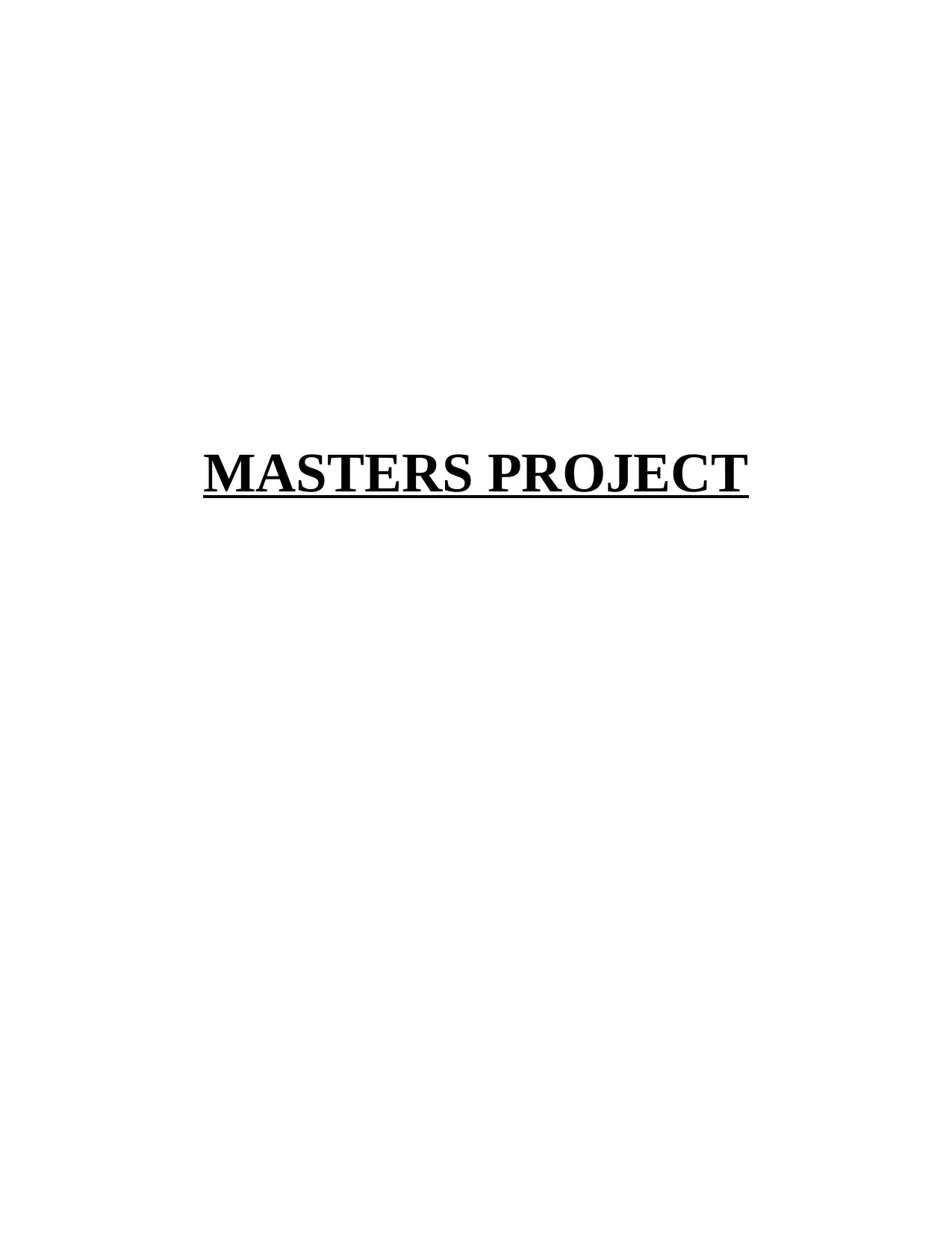
MASTERS PROJECT
Paraphrase This Document
Need a fresh take? Get an instant paraphrase of this document with our AI Paraphraser
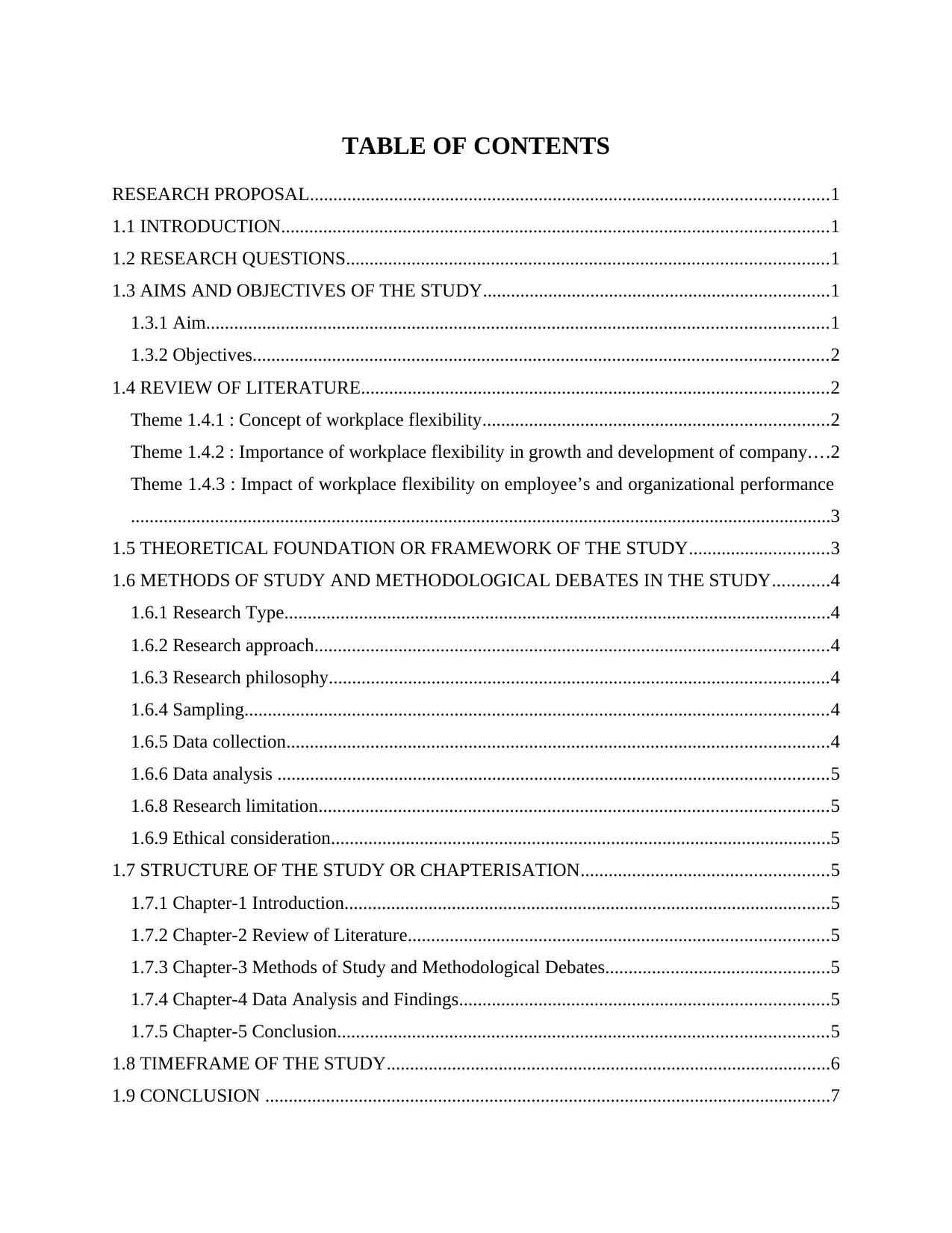
TABLE OF CONTENTS
RESEARCH PROPOSAL...............................................................................................................1
1.1 INTRODUCTION.....................................................................................................................1
1.2 RESEARCH QUESTIONS.......................................................................................................1
1.3 AIMS AND OBJECTIVES OF THE STUDY..........................................................................1
1.3.1 Aim.....................................................................................................................................1
1.3.2 Objectives...........................................................................................................................2
1.4 REVIEW OF LITERATURE....................................................................................................2
Theme 1.4.1 : Concept of workplace flexibility..........................................................................2
Theme 1.4.2 : Importance of workplace flexibility in growth and development of company....2
Theme 1.4.3 : Impact of workplace flexibility on employee’s and organizational performance
......................................................................................................................................................3
1.5 THEORETICAL FOUNDATION OR FRAMEWORK OF THE STUDY..............................3
1.6 METHODS OF STUDY AND METHODOLOGICAL DEBATES IN THE STUDY............4
1.6.1 Research Type.....................................................................................................................4
1.6.2 Research approach..............................................................................................................4
1.6.3 Research philosophy...........................................................................................................4
1.6.4 Sampling.............................................................................................................................4
1.6.5 Data collection....................................................................................................................4
1.6.6 Data analysis ......................................................................................................................5
1.6.8 Research limitation.............................................................................................................5
1.6.9 Ethical consideration...........................................................................................................5
1.7 STRUCTURE OF THE STUDY OR CHAPTERISATION.....................................................5
1.7.1 Chapter-1 Introduction........................................................................................................5
1.7.2 Chapter-2 Review of Literature..........................................................................................5
1.7.3 Chapter-3 Methods of Study and Methodological Debates................................................5
1.7.4 Chapter-4 Data Analysis and Findings...............................................................................5
1.7.5 Chapter-5 Conclusion.........................................................................................................5
1.8 TIMEFRAME OF THE STUDY...............................................................................................6
1.9 CONCLUSION .........................................................................................................................7
RESEARCH PROPOSAL...............................................................................................................1
1.1 INTRODUCTION.....................................................................................................................1
1.2 RESEARCH QUESTIONS.......................................................................................................1
1.3 AIMS AND OBJECTIVES OF THE STUDY..........................................................................1
1.3.1 Aim.....................................................................................................................................1
1.3.2 Objectives...........................................................................................................................2
1.4 REVIEW OF LITERATURE....................................................................................................2
Theme 1.4.1 : Concept of workplace flexibility..........................................................................2
Theme 1.4.2 : Importance of workplace flexibility in growth and development of company....2
Theme 1.4.3 : Impact of workplace flexibility on employee’s and organizational performance
......................................................................................................................................................3
1.5 THEORETICAL FOUNDATION OR FRAMEWORK OF THE STUDY..............................3
1.6 METHODS OF STUDY AND METHODOLOGICAL DEBATES IN THE STUDY............4
1.6.1 Research Type.....................................................................................................................4
1.6.2 Research approach..............................................................................................................4
1.6.3 Research philosophy...........................................................................................................4
1.6.4 Sampling.............................................................................................................................4
1.6.5 Data collection....................................................................................................................4
1.6.6 Data analysis ......................................................................................................................5
1.6.8 Research limitation.............................................................................................................5
1.6.9 Ethical consideration...........................................................................................................5
1.7 STRUCTURE OF THE STUDY OR CHAPTERISATION.....................................................5
1.7.1 Chapter-1 Introduction........................................................................................................5
1.7.2 Chapter-2 Review of Literature..........................................................................................5
1.7.3 Chapter-3 Methods of Study and Methodological Debates................................................5
1.7.4 Chapter-4 Data Analysis and Findings...............................................................................5
1.7.5 Chapter-5 Conclusion.........................................................................................................5
1.8 TIMEFRAME OF THE STUDY...............................................................................................6
1.9 CONCLUSION .........................................................................................................................7

CHAPTER-1 INTRODUCTION....................................................................................................8
1.1 OVERVIEW .............................................................................................................................8
1.2 AIMS AND OBJECTIVES OF THE STUDY..........................................................................8
1.3.1 Aim.....................................................................................................................................8
1.3.2 Objectives...........................................................................................................................8
1.3 RESEARCH QUESTIONS.......................................................................................................8
1.4 SIGNIFICANCE OF THE STUDY..........................................................................................9
1.5 RATIONALE.............................................................................................................................9
CHAPTER-2 LITERATURE REVIEW .......................................................................................10
To understand the concept of workplace flexibility. (200)........................................................10
To identify the importance of workplace flexibility in growth and development of company. 10
To evaluate impact of workplace flexibility on employee’s and organizational performance of
Morrison.....................................................................................................................................11
CHAPTER- 3 RESEARCH METHODOLOGY...........................................................................14
CHAPTER -4 DATA ANALYSIS ...............................................................................................17
Theme 1: Both of the above options has been selected by maximum number of respondent...17
Theme 2: Yes, the manager of Morrison's give importance to workplace flexibility in the
firm.............................................................................................................................................18
Theme 3: All are the importance of workplace flexibility for Morrison's.................................18
Theme 4: Transparency, adaptability and providing respect to others are different workplace
value abide in the company........................................................................................................19
Theme 5: Create a good public image and increase employee attendance and morale are
positive impact of workplace flexibility in context of employee's and organization
performance...............................................................................................................................20
Theme 6: Problem with managing time, unreliable and untrustworthy employees and handling
clients are negative impact of workplace flexibility on individual and company performance.
....................................................................................................................................................21
Theme 7: Work from home options and Workplace independence are two major strategies
that are used by company to promote flexible working practice in company...........................23
Theme 8: Tracking attendance and output are challenges face by company while taking steps
towards the flexible working practice for its benefits................................................................24
1.1 OVERVIEW .............................................................................................................................8
1.2 AIMS AND OBJECTIVES OF THE STUDY..........................................................................8
1.3.1 Aim.....................................................................................................................................8
1.3.2 Objectives...........................................................................................................................8
1.3 RESEARCH QUESTIONS.......................................................................................................8
1.4 SIGNIFICANCE OF THE STUDY..........................................................................................9
1.5 RATIONALE.............................................................................................................................9
CHAPTER-2 LITERATURE REVIEW .......................................................................................10
To understand the concept of workplace flexibility. (200)........................................................10
To identify the importance of workplace flexibility in growth and development of company. 10
To evaluate impact of workplace flexibility on employee’s and organizational performance of
Morrison.....................................................................................................................................11
CHAPTER- 3 RESEARCH METHODOLOGY...........................................................................14
CHAPTER -4 DATA ANALYSIS ...............................................................................................17
Theme 1: Both of the above options has been selected by maximum number of respondent...17
Theme 2: Yes, the manager of Morrison's give importance to workplace flexibility in the
firm.............................................................................................................................................18
Theme 3: All are the importance of workplace flexibility for Morrison's.................................18
Theme 4: Transparency, adaptability and providing respect to others are different workplace
value abide in the company........................................................................................................19
Theme 5: Create a good public image and increase employee attendance and morale are
positive impact of workplace flexibility in context of employee's and organization
performance...............................................................................................................................20
Theme 6: Problem with managing time, unreliable and untrustworthy employees and handling
clients are negative impact of workplace flexibility on individual and company performance.
....................................................................................................................................................21
Theme 7: Work from home options and Workplace independence are two major strategies
that are used by company to promote flexible working practice in company...........................23
Theme 8: Tracking attendance and output are challenges face by company while taking steps
towards the flexible working practice for its benefits................................................................24
⊘ This is a preview!⊘
Do you want full access?
Subscribe today to unlock all pages.

Trusted by 1+ million students worldwide
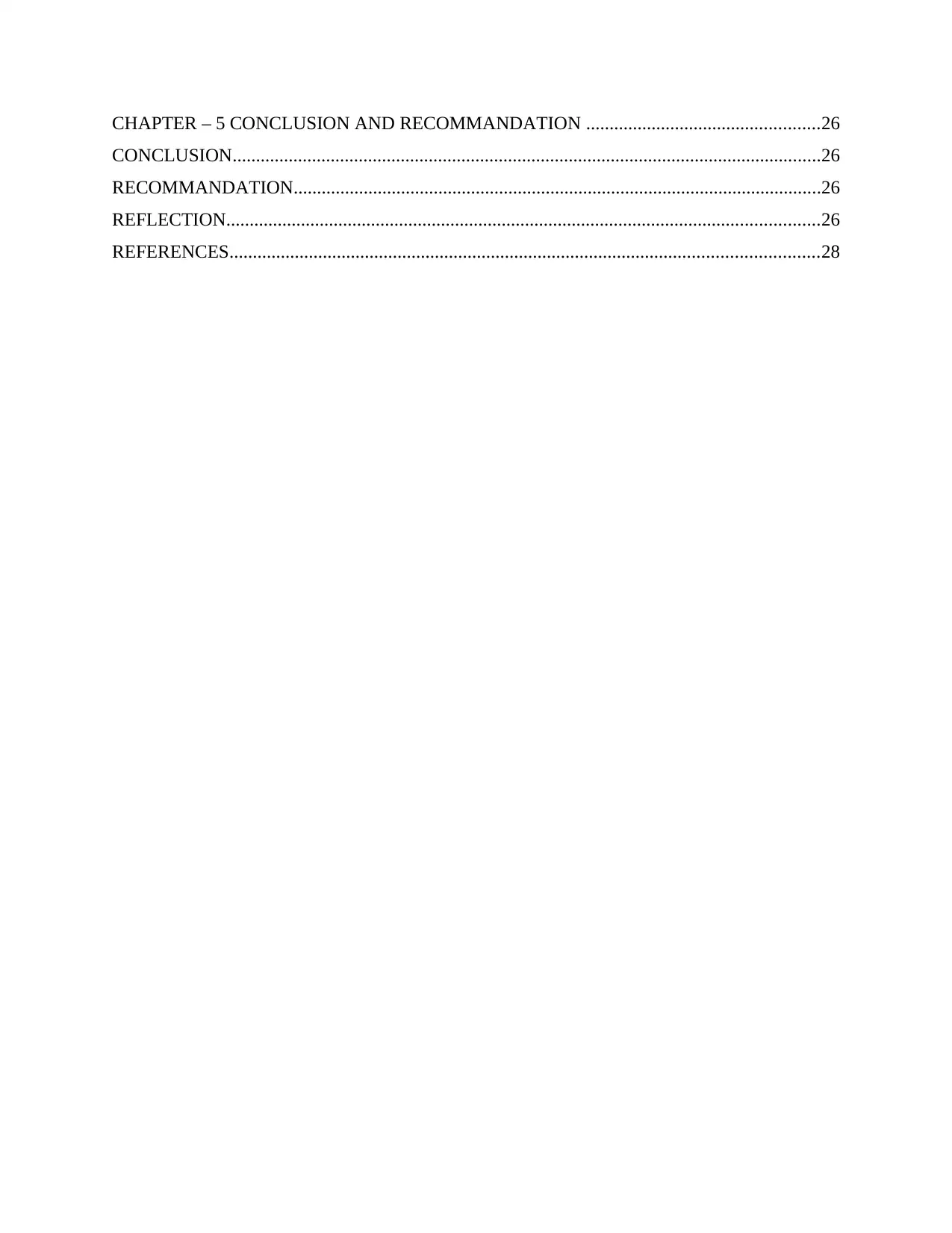
CHAPTER – 5 CONCLUSION AND RECOMMANDATION ..................................................26
CONCLUSION..............................................................................................................................26
RECOMMANDATION.................................................................................................................26
REFLECTION...............................................................................................................................26
REFERENCES..............................................................................................................................28
CONCLUSION..............................................................................................................................26
RECOMMANDATION.................................................................................................................26
REFLECTION...............................................................................................................................26
REFERENCES..............................................................................................................................28
Paraphrase This Document
Need a fresh take? Get an instant paraphrase of this document with our AI Paraphraser
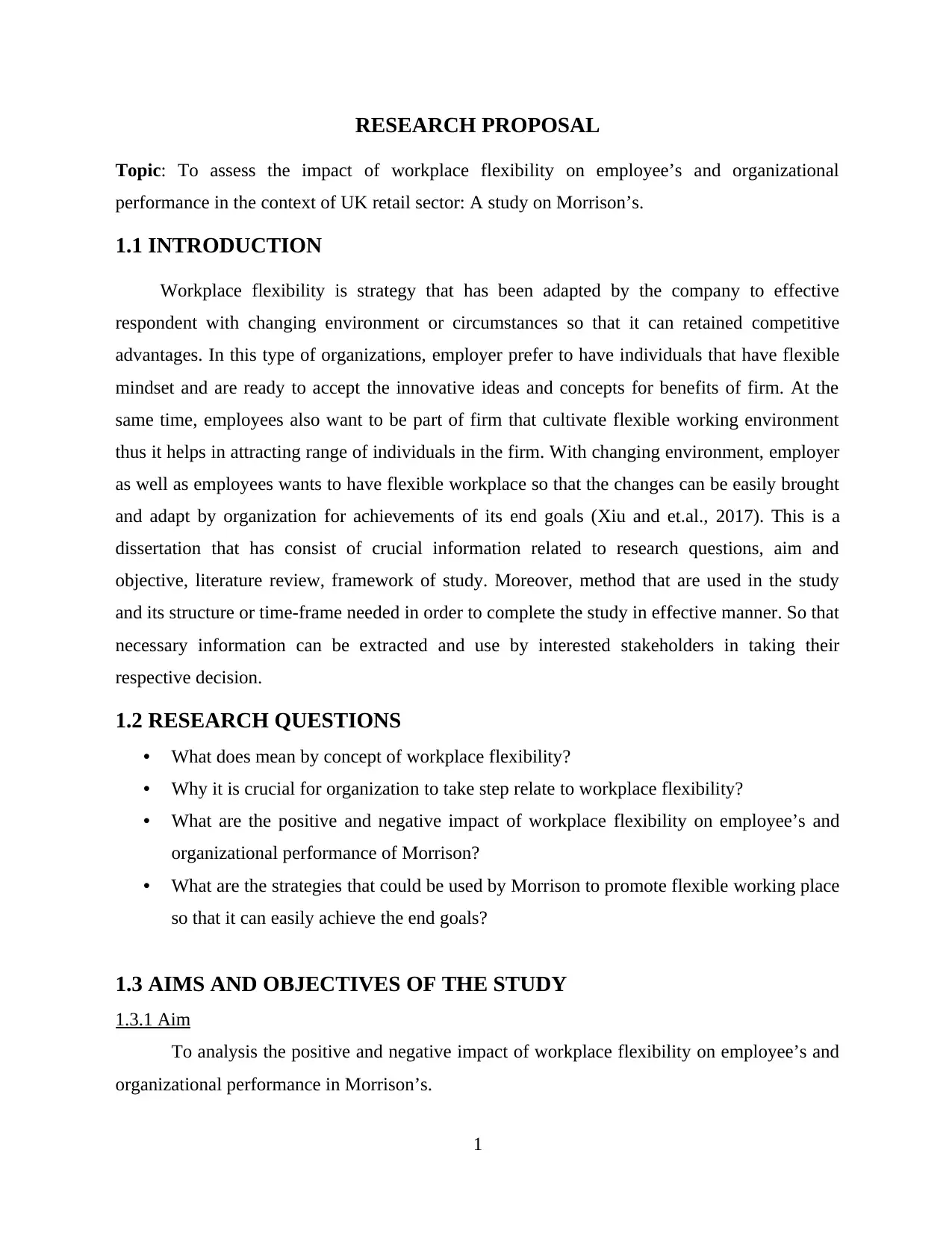
RESEARCH PROPOSAL
Topic: To assess the impact of workplace flexibility on employee’s and organizational
performance in the context of UK retail sector: A study on Morrison’s.
1.1 INTRODUCTION
Workplace flexibility is strategy that has been adapted by the company to effective
respondent with changing environment or circumstances so that it can retained competitive
advantages. In this type of organizations, employer prefer to have individuals that have flexible
mindset and are ready to accept the innovative ideas and concepts for benefits of firm. At the
same time, employees also want to be part of firm that cultivate flexible working environment
thus it helps in attracting range of individuals in the firm. With changing environment, employer
as well as employees wants to have flexible workplace so that the changes can be easily brought
and adapt by organization for achievements of its end goals (Xiu and et.al., 2017). This is a
dissertation that has consist of crucial information related to research questions, aim and
objective, literature review, framework of study. Moreover, method that are used in the study
and its structure or time-frame needed in order to complete the study in effective manner. So that
necessary information can be extracted and use by interested stakeholders in taking their
respective decision.
1.2 RESEARCH QUESTIONS
• What does mean by concept of workplace flexibility?
• Why it is crucial for organization to take step relate to workplace flexibility?
• What are the positive and negative impact of workplace flexibility on employee’s and
organizational performance of Morrison?
• What are the strategies that could be used by Morrison to promote flexible working place
so that it can easily achieve the end goals?
1.3 AIMS AND OBJECTIVES OF THE STUDY
1.3.1 Aim
To analysis the positive and negative impact of workplace flexibility on employee’s and
organizational performance in Morrison’s.
1
Topic: To assess the impact of workplace flexibility on employee’s and organizational
performance in the context of UK retail sector: A study on Morrison’s.
1.1 INTRODUCTION
Workplace flexibility is strategy that has been adapted by the company to effective
respondent with changing environment or circumstances so that it can retained competitive
advantages. In this type of organizations, employer prefer to have individuals that have flexible
mindset and are ready to accept the innovative ideas and concepts for benefits of firm. At the
same time, employees also want to be part of firm that cultivate flexible working environment
thus it helps in attracting range of individuals in the firm. With changing environment, employer
as well as employees wants to have flexible workplace so that the changes can be easily brought
and adapt by organization for achievements of its end goals (Xiu and et.al., 2017). This is a
dissertation that has consist of crucial information related to research questions, aim and
objective, literature review, framework of study. Moreover, method that are used in the study
and its structure or time-frame needed in order to complete the study in effective manner. So that
necessary information can be extracted and use by interested stakeholders in taking their
respective decision.
1.2 RESEARCH QUESTIONS
• What does mean by concept of workplace flexibility?
• Why it is crucial for organization to take step relate to workplace flexibility?
• What are the positive and negative impact of workplace flexibility on employee’s and
organizational performance of Morrison?
• What are the strategies that could be used by Morrison to promote flexible working place
so that it can easily achieve the end goals?
1.3 AIMS AND OBJECTIVES OF THE STUDY
1.3.1 Aim
To analysis the positive and negative impact of workplace flexibility on employee’s and
organizational performance in Morrison’s.
1

1.3.2 Objectives
• To understand the concept of workplace flexibility.
• To identify the importance of workplace flexibility in growth and development of
company.
• To evaluate impact of workplace flexibility on employee’s and organizational
performance of Morrison.
• To suggest strategies that could be used to promote flexible working place in Morrison
for its expansion in international market.
1.4 REVIEW OF LITERATURE
Theme 1.4.1 : Concept of workplace flexibility
From the point of view of Oludayo and et.al., (2018), workplace flexibility is the concept
that emphasis on being willing to effectively adapt the strategy as per changing environment so
that company can grow and sustain for longer run. This is a concept that contribute in meeting
needs of both employees as well as business. Likewise, workplace flexibility lead in enhancing
work life balance of individuals and contribute in retaining more and more talented employees in
the firm for longer time frame. With globalisation and rapid increase in competition level,
companies as well as employers are preferring to have workplace flexibility so that employees
can find new and innovative ideas to promote growth and expansion of business. Therefore,
workplace flexibility helps in reducing the stress level of individuals and maximisation of
overall productivity of firm.
Theme 1.4.2 : Importance of workplace flexibility in growth and development of company
The Rožman, Treven and Čančer (2017), illustrate that there are numerous importance of
workplace flexibility so firm needs to take steps to promote the same in order to gain optimum
outcome. The first and foremost benefits of flexible working place is that it leads in lowering the
stress level of individuals through providing them flexible and free environment. At the same
time, it also contributes in improving overall productivity and performance of individuals as they
make use of new and differentiate method to complete their respective task. The author
furthermore states that it helps in building trust between the individuals so that they can co-
ordinately work towards achievement of last goals of firm.
2
• To understand the concept of workplace flexibility.
• To identify the importance of workplace flexibility in growth and development of
company.
• To evaluate impact of workplace flexibility on employee’s and organizational
performance of Morrison.
• To suggest strategies that could be used to promote flexible working place in Morrison
for its expansion in international market.
1.4 REVIEW OF LITERATURE
Theme 1.4.1 : Concept of workplace flexibility
From the point of view of Oludayo and et.al., (2018), workplace flexibility is the concept
that emphasis on being willing to effectively adapt the strategy as per changing environment so
that company can grow and sustain for longer run. This is a concept that contribute in meeting
needs of both employees as well as business. Likewise, workplace flexibility lead in enhancing
work life balance of individuals and contribute in retaining more and more talented employees in
the firm for longer time frame. With globalisation and rapid increase in competition level,
companies as well as employers are preferring to have workplace flexibility so that employees
can find new and innovative ideas to promote growth and expansion of business. Therefore,
workplace flexibility helps in reducing the stress level of individuals and maximisation of
overall productivity of firm.
Theme 1.4.2 : Importance of workplace flexibility in growth and development of company
The Rožman, Treven and Čančer (2017), illustrate that there are numerous importance of
workplace flexibility so firm needs to take steps to promote the same in order to gain optimum
outcome. The first and foremost benefits of flexible working place is that it leads in lowering the
stress level of individuals through providing them flexible and free environment. At the same
time, it also contributes in improving overall productivity and performance of individuals as they
make use of new and differentiate method to complete their respective task. The author
furthermore states that it helps in building trust between the individuals so that they can co-
ordinately work towards achievement of last goals of firm.
2
⊘ This is a preview!⊘
Do you want full access?
Subscribe today to unlock all pages.

Trusted by 1+ million students worldwide
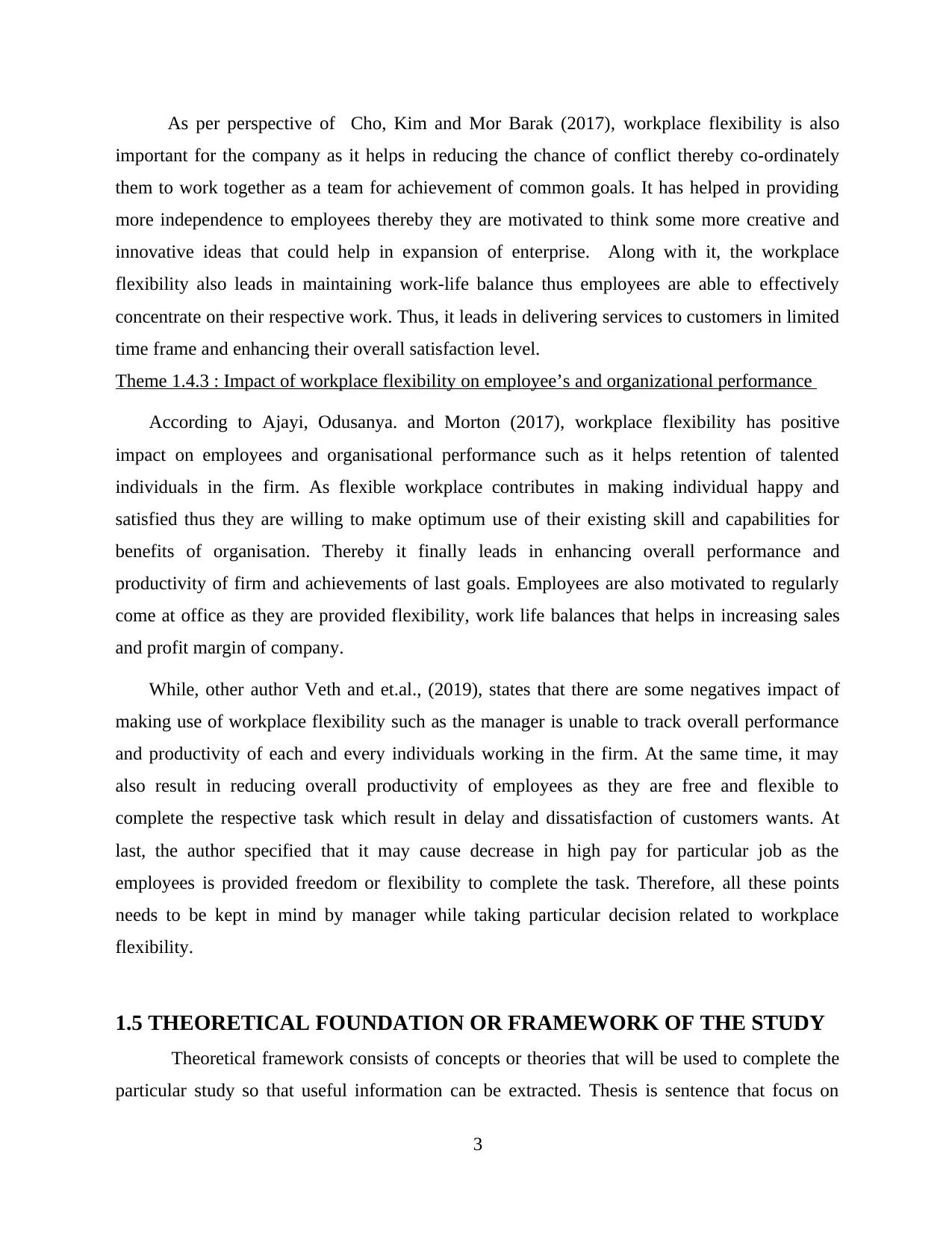
As per perspective of Cho, Kim and Mor Barak (2017), workplace flexibility is also
important for the company as it helps in reducing the chance of conflict thereby co-ordinately
them to work together as a team for achievement of common goals. It has helped in providing
more independence to employees thereby they are motivated to think some more creative and
innovative ideas that could help in expansion of enterprise. Along with it, the workplace
flexibility also leads in maintaining work-life balance thus employees are able to effectively
concentrate on their respective work. Thus, it leads in delivering services to customers in limited
time frame and enhancing their overall satisfaction level.
Theme 1.4.3 : Impact of workplace flexibility on employee’s and organizational performance
According to Ajayi, Odusanya. and Morton (2017), workplace flexibility has positive
impact on employees and organisational performance such as it helps retention of talented
individuals in the firm. As flexible workplace contributes in making individual happy and
satisfied thus they are willing to make optimum use of their existing skill and capabilities for
benefits of organisation. Thereby it finally leads in enhancing overall performance and
productivity of firm and achievements of last goals. Employees are also motivated to regularly
come at office as they are provided flexibility, work life balances that helps in increasing sales
and profit margin of company.
While, other author Veth and et.al., (2019), states that there are some negatives impact of
making use of workplace flexibility such as the manager is unable to track overall performance
and productivity of each and every individuals working in the firm. At the same time, it may
also result in reducing overall productivity of employees as they are free and flexible to
complete the respective task which result in delay and dissatisfaction of customers wants. At
last, the author specified that it may cause decrease in high pay for particular job as the
employees is provided freedom or flexibility to complete the task. Therefore, all these points
needs to be kept in mind by manager while taking particular decision related to workplace
flexibility.
1.5 THEORETICAL FOUNDATION OR FRAMEWORK OF THE STUDY
Theoretical framework consists of concepts or theories that will be used to complete the
particular study so that useful information can be extracted. Thesis is sentence that focus on
3
important for the company as it helps in reducing the chance of conflict thereby co-ordinately
them to work together as a team for achievement of common goals. It has helped in providing
more independence to employees thereby they are motivated to think some more creative and
innovative ideas that could help in expansion of enterprise. Along with it, the workplace
flexibility also leads in maintaining work-life balance thus employees are able to effectively
concentrate on their respective work. Thus, it leads in delivering services to customers in limited
time frame and enhancing their overall satisfaction level.
Theme 1.4.3 : Impact of workplace flexibility on employee’s and organizational performance
According to Ajayi, Odusanya. and Morton (2017), workplace flexibility has positive
impact on employees and organisational performance such as it helps retention of talented
individuals in the firm. As flexible workplace contributes in making individual happy and
satisfied thus they are willing to make optimum use of their existing skill and capabilities for
benefits of organisation. Thereby it finally leads in enhancing overall performance and
productivity of firm and achievements of last goals. Employees are also motivated to regularly
come at office as they are provided flexibility, work life balances that helps in increasing sales
and profit margin of company.
While, other author Veth and et.al., (2019), states that there are some negatives impact of
making use of workplace flexibility such as the manager is unable to track overall performance
and productivity of each and every individuals working in the firm. At the same time, it may
also result in reducing overall productivity of employees as they are free and flexible to
complete the respective task which result in delay and dissatisfaction of customers wants. At
last, the author specified that it may cause decrease in high pay for particular job as the
employees is provided freedom or flexibility to complete the task. Therefore, all these points
needs to be kept in mind by manager while taking particular decision related to workplace
flexibility.
1.5 THEORETICAL FOUNDATION OR FRAMEWORK OF THE STUDY
Theoretical framework consists of concepts or theories that will be used to complete the
particular study so that useful information can be extracted. Thesis is sentence that focus on
3
Paraphrase This Document
Need a fresh take? Get an instant paraphrase of this document with our AI Paraphraser

ideas that are used in the paper thus it crystallised the ideas into single sentences so that the
reader can get main idea (Pandita and Ray, 2018). Thus, it will help the interested individuals in
understanding the purpose or objective of the research and the way it can be useful in
completing the study in most effective manner.
1.6 METHODS OF STUDY AND METHODOLOGICAL DEBATES IN THE
STUDY
1.6.1 Research Type
Research type can be categorised into two qualitative and quantitative methods, in
qualitative numerical are not used. While in quantitative method only facts, figure and data are
used to describe the information gathered through pursing the study. Thus, the researcher has
plan to make use of qualitative approach as it helps in conducting in-depth study on particular
subject area.
1.6.2 Research approach
Scholar can make use of both inductive and deductive approach in order to complete its
study and extract useful information related to impact of workplace flexibility on employees and
organisation performance. Out of which the researcher will make use of inductive approach as it
is best suitable for qualitative method (Pandita and Ray, 2018).
1.6.3 Research philosophy
Research philosophy specify about the point of view or belief that has been considered by
researcher while accomplishing the study. Interpretativism, realism and positivism are three
research philosophy that could be used by scholar. So interpretativism has been selected because
in this the scholar will interpretate the elements of study.
1.6.4 Sampling
Sampling is an statistical process that involves collection of view of few individual out of
group to come at particular. Random sampling will be opted by researcher as in it equal chance
is provided to all respondent to answer.
1.6.5 Data collection
Primary and secondary are two crucial methods that are used to collect information, so
both will be used to complete study (Frenkel, 2019). So that more and more information can be
gathered in limited time frame.
4
reader can get main idea (Pandita and Ray, 2018). Thus, it will help the interested individuals in
understanding the purpose or objective of the research and the way it can be useful in
completing the study in most effective manner.
1.6 METHODS OF STUDY AND METHODOLOGICAL DEBATES IN THE
STUDY
1.6.1 Research Type
Research type can be categorised into two qualitative and quantitative methods, in
qualitative numerical are not used. While in quantitative method only facts, figure and data are
used to describe the information gathered through pursing the study. Thus, the researcher has
plan to make use of qualitative approach as it helps in conducting in-depth study on particular
subject area.
1.6.2 Research approach
Scholar can make use of both inductive and deductive approach in order to complete its
study and extract useful information related to impact of workplace flexibility on employees and
organisation performance. Out of which the researcher will make use of inductive approach as it
is best suitable for qualitative method (Pandita and Ray, 2018).
1.6.3 Research philosophy
Research philosophy specify about the point of view or belief that has been considered by
researcher while accomplishing the study. Interpretativism, realism and positivism are three
research philosophy that could be used by scholar. So interpretativism has been selected because
in this the scholar will interpretate the elements of study.
1.6.4 Sampling
Sampling is an statistical process that involves collection of view of few individual out of
group to come at particular. Random sampling will be opted by researcher as in it equal chance
is provided to all respondent to answer.
1.6.5 Data collection
Primary and secondary are two crucial methods that are used to collect information, so
both will be used to complete study (Frenkel, 2019). So that more and more information can be
gathered in limited time frame.
4
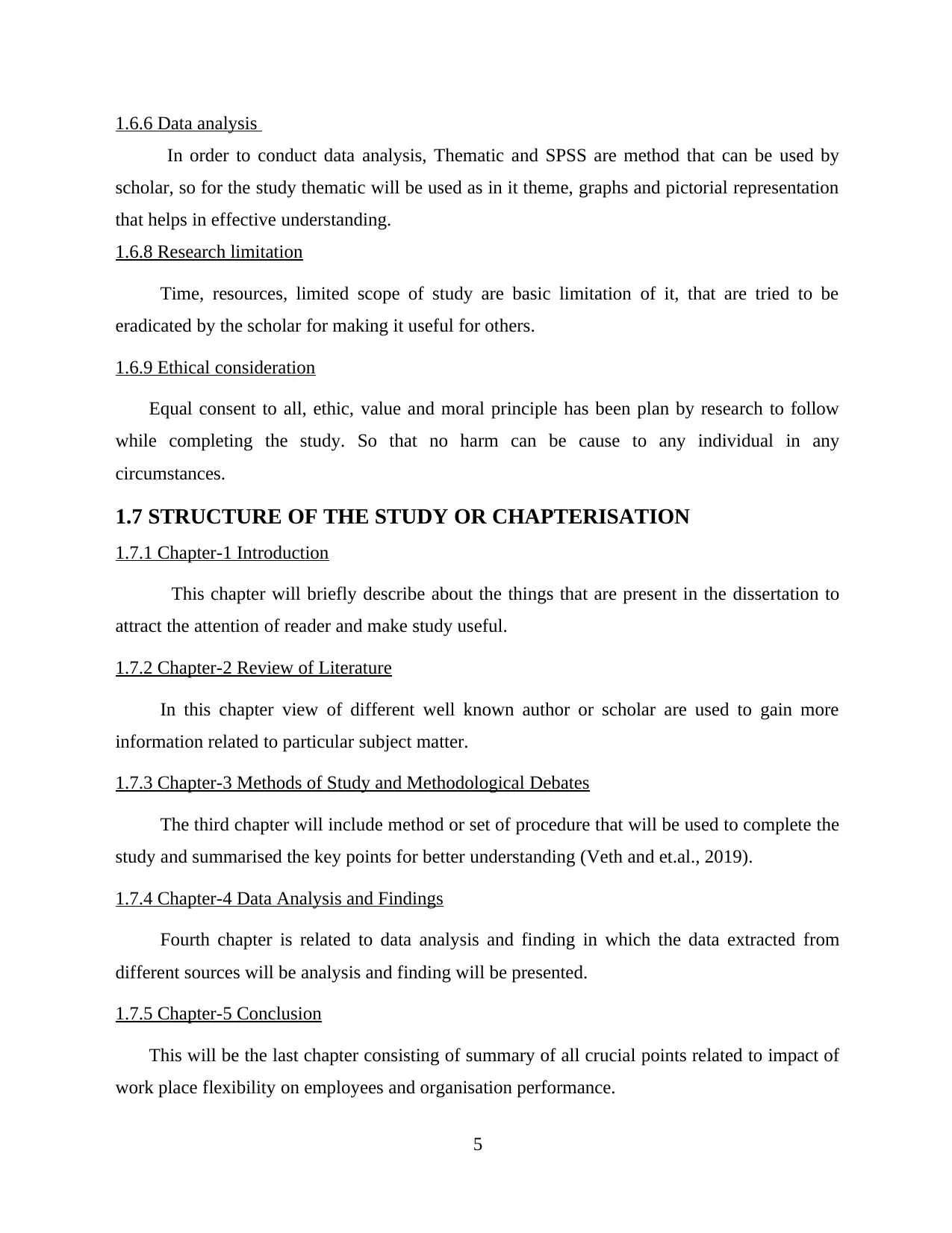
1.6.6 Data analysis
In order to conduct data analysis, Thematic and SPSS are method that can be used by
scholar, so for the study thematic will be used as in it theme, graphs and pictorial representation
that helps in effective understanding.
1.6.8 Research limitation
Time, resources, limited scope of study are basic limitation of it, that are tried to be
eradicated by the scholar for making it useful for others.
1.6.9 Ethical consideration
Equal consent to all, ethic, value and moral principle has been plan by research to follow
while completing the study. So that no harm can be cause to any individual in any
circumstances.
1.7 STRUCTURE OF THE STUDY OR CHAPTERISATION
1.7.1 Chapter-1 Introduction
This chapter will briefly describe about the things that are present in the dissertation to
attract the attention of reader and make study useful.
1.7.2 Chapter-2 Review of Literature
In this chapter view of different well known author or scholar are used to gain more
information related to particular subject matter.
1.7.3 Chapter-3 Methods of Study and Methodological Debates
The third chapter will include method or set of procedure that will be used to complete the
study and summarised the key points for better understanding (Veth and et.al., 2019).
1.7.4 Chapter-4 Data Analysis and Findings
Fourth chapter is related to data analysis and finding in which the data extracted from
different sources will be analysis and finding will be presented.
1.7.5 Chapter-5 Conclusion
This will be the last chapter consisting of summary of all crucial points related to impact of
work place flexibility on employees and organisation performance.
5
In order to conduct data analysis, Thematic and SPSS are method that can be used by
scholar, so for the study thematic will be used as in it theme, graphs and pictorial representation
that helps in effective understanding.
1.6.8 Research limitation
Time, resources, limited scope of study are basic limitation of it, that are tried to be
eradicated by the scholar for making it useful for others.
1.6.9 Ethical consideration
Equal consent to all, ethic, value and moral principle has been plan by research to follow
while completing the study. So that no harm can be cause to any individual in any
circumstances.
1.7 STRUCTURE OF THE STUDY OR CHAPTERISATION
1.7.1 Chapter-1 Introduction
This chapter will briefly describe about the things that are present in the dissertation to
attract the attention of reader and make study useful.
1.7.2 Chapter-2 Review of Literature
In this chapter view of different well known author or scholar are used to gain more
information related to particular subject matter.
1.7.3 Chapter-3 Methods of Study and Methodological Debates
The third chapter will include method or set of procedure that will be used to complete the
study and summarised the key points for better understanding (Veth and et.al., 2019).
1.7.4 Chapter-4 Data Analysis and Findings
Fourth chapter is related to data analysis and finding in which the data extracted from
different sources will be analysis and finding will be presented.
1.7.5 Chapter-5 Conclusion
This will be the last chapter consisting of summary of all crucial points related to impact of
work place flexibility on employees and organisation performance.
5
⊘ This is a preview!⊘
Do you want full access?
Subscribe today to unlock all pages.

Trusted by 1+ million students worldwide
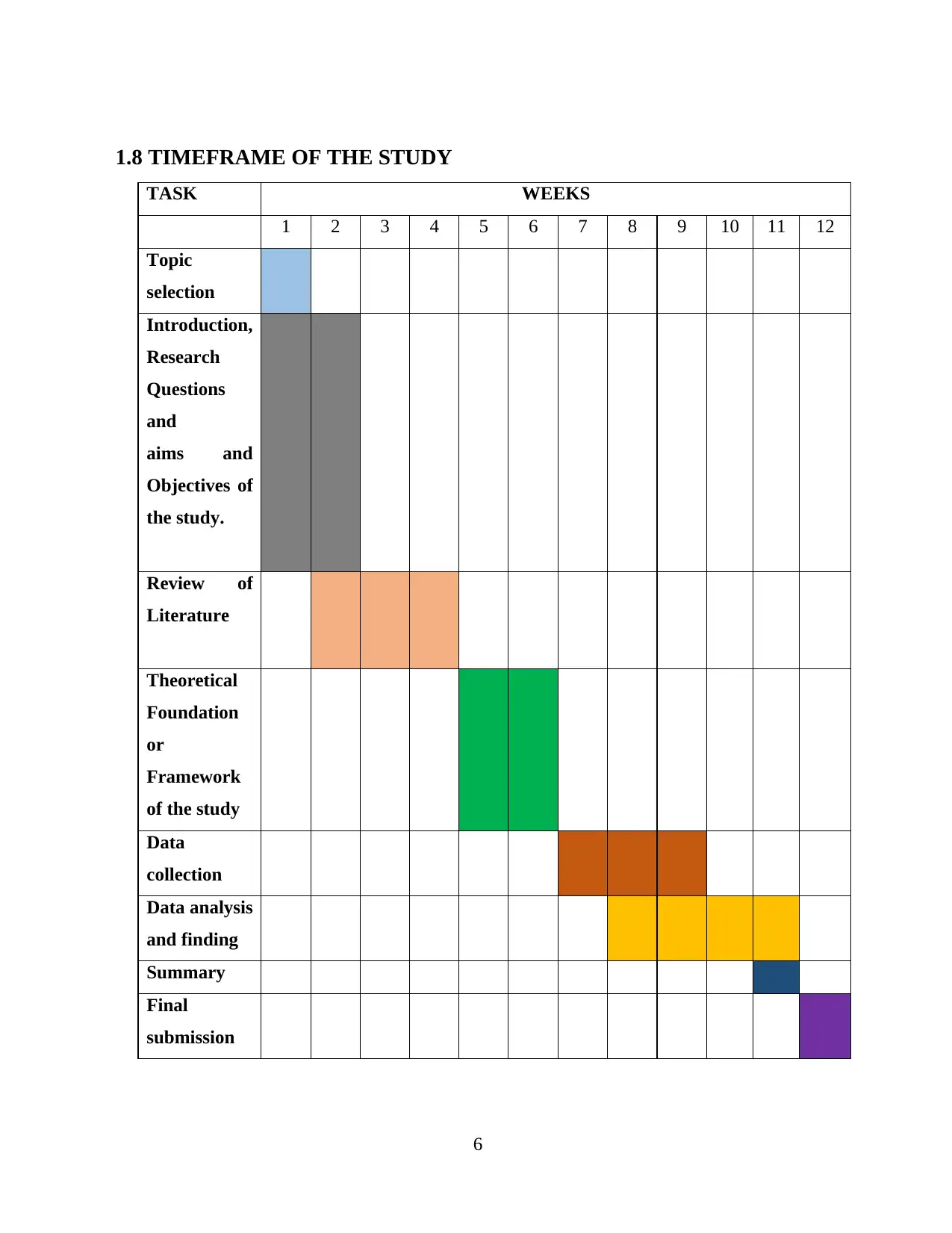
1.8 TIMEFRAME OF THE STUDY
TASK WEEKS
1 2 3 4 5 6 7 8 9 10 11 12
Topic
selection
Introduction,
Research
Questions
and
aims and
Objectives of
the study.
Review of
Literature
Theoretical
Foundation
or
Framework
of the study
Data
collection
Data analysis
and finding
Summary
Final
submission
6
TASK WEEKS
1 2 3 4 5 6 7 8 9 10 11 12
Topic
selection
Introduction,
Research
Questions
and
aims and
Objectives of
the study.
Review of
Literature
Theoretical
Foundation
or
Framework
of the study
Data
collection
Data analysis
and finding
Summary
Final
submission
6
Paraphrase This Document
Need a fresh take? Get an instant paraphrase of this document with our AI Paraphraser
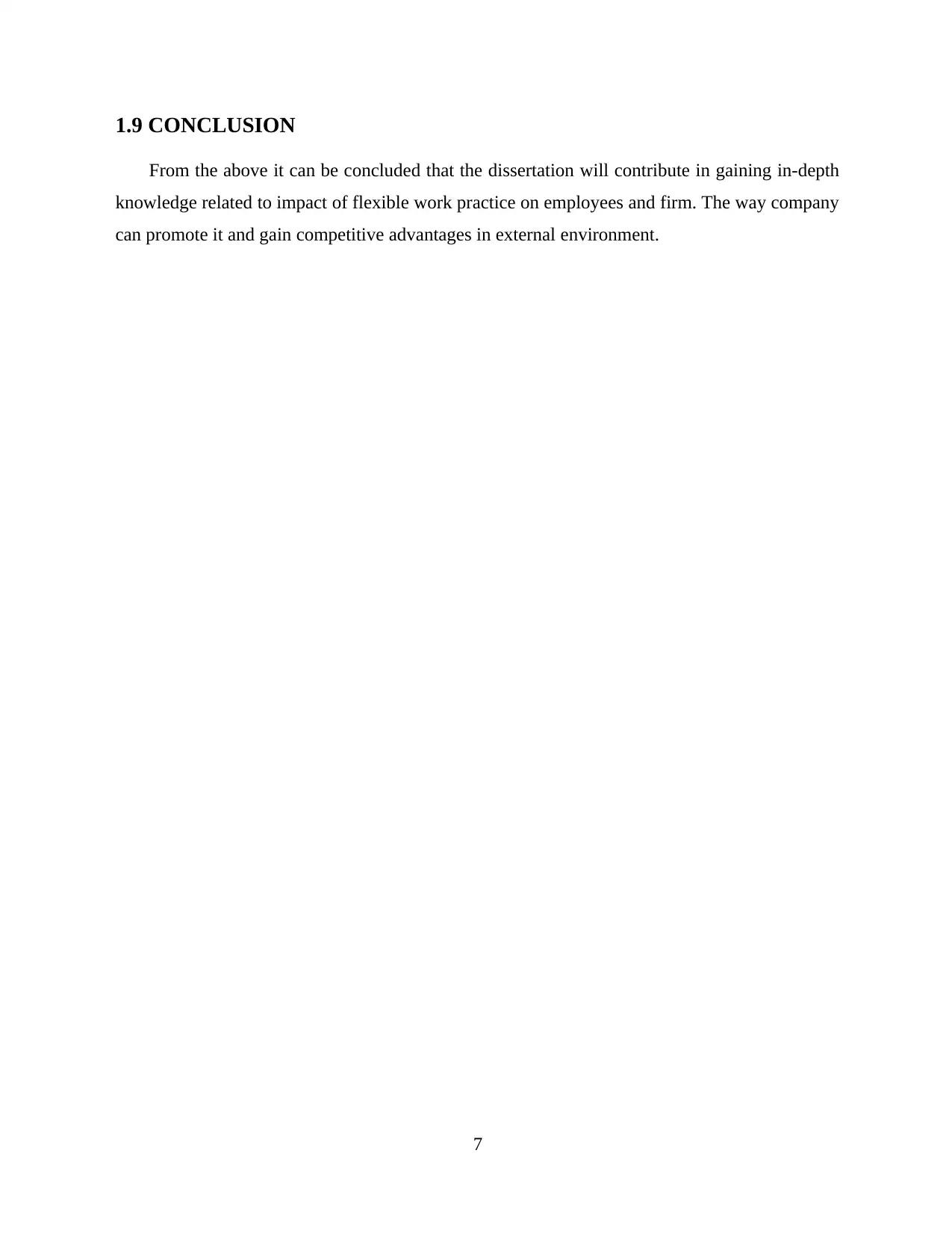
1.9 CONCLUSION
From the above it can be concluded that the dissertation will contribute in gaining in-depth
knowledge related to impact of flexible work practice on employees and firm. The way company
can promote it and gain competitive advantages in external environment.
7
From the above it can be concluded that the dissertation will contribute in gaining in-depth
knowledge related to impact of flexible work practice on employees and firm. The way company
can promote it and gain competitive advantages in external environment.
7
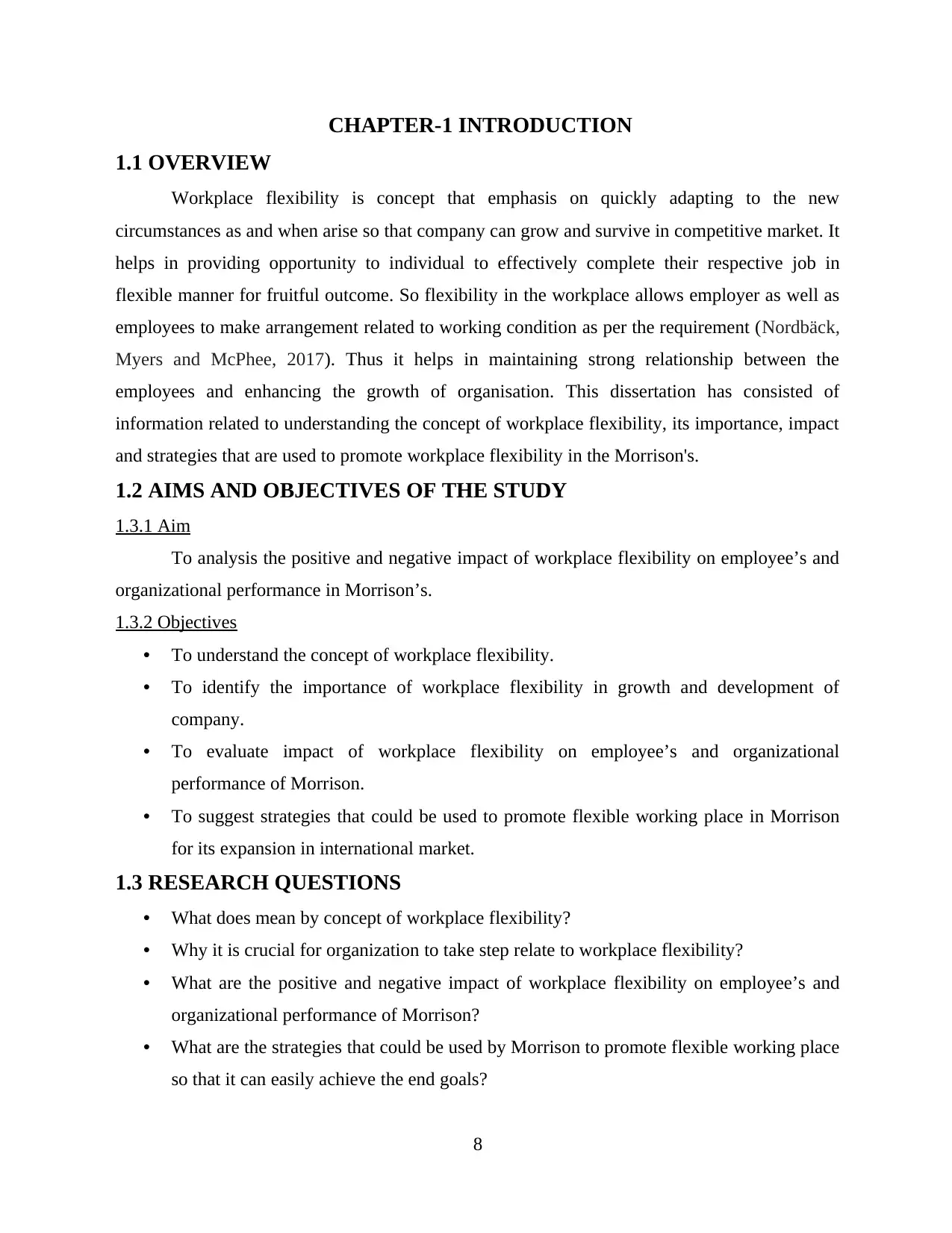
CHAPTER-1 INTRODUCTION
1.1 OVERVIEW
Workplace flexibility is concept that emphasis on quickly adapting to the new
circumstances as and when arise so that company can grow and survive in competitive market. It
helps in providing opportunity to individual to effectively complete their respective job in
flexible manner for fruitful outcome. So flexibility in the workplace allows employer as well as
employees to make arrangement related to working condition as per the requirement (Nordbäck,
Myers and McPhee, 2017). Thus it helps in maintaining strong relationship between the
employees and enhancing the growth of organisation. This dissertation has consisted of
information related to understanding the concept of workplace flexibility, its importance, impact
and strategies that are used to promote workplace flexibility in the Morrison's.
1.2 AIMS AND OBJECTIVES OF THE STUDY
1.3.1 Aim
To analysis the positive and negative impact of workplace flexibility on employee’s and
organizational performance in Morrison’s.
1.3.2 Objectives
• To understand the concept of workplace flexibility.
• To identify the importance of workplace flexibility in growth and development of
company.
• To evaluate impact of workplace flexibility on employee’s and organizational
performance of Morrison.
• To suggest strategies that could be used to promote flexible working place in Morrison
for its expansion in international market.
1.3 RESEARCH QUESTIONS
• What does mean by concept of workplace flexibility?
• Why it is crucial for organization to take step relate to workplace flexibility?
• What are the positive and negative impact of workplace flexibility on employee’s and
organizational performance of Morrison?
• What are the strategies that could be used by Morrison to promote flexible working place
so that it can easily achieve the end goals?
8
1.1 OVERVIEW
Workplace flexibility is concept that emphasis on quickly adapting to the new
circumstances as and when arise so that company can grow and survive in competitive market. It
helps in providing opportunity to individual to effectively complete their respective job in
flexible manner for fruitful outcome. So flexibility in the workplace allows employer as well as
employees to make arrangement related to working condition as per the requirement (Nordbäck,
Myers and McPhee, 2017). Thus it helps in maintaining strong relationship between the
employees and enhancing the growth of organisation. This dissertation has consisted of
information related to understanding the concept of workplace flexibility, its importance, impact
and strategies that are used to promote workplace flexibility in the Morrison's.
1.2 AIMS AND OBJECTIVES OF THE STUDY
1.3.1 Aim
To analysis the positive and negative impact of workplace flexibility on employee’s and
organizational performance in Morrison’s.
1.3.2 Objectives
• To understand the concept of workplace flexibility.
• To identify the importance of workplace flexibility in growth and development of
company.
• To evaluate impact of workplace flexibility on employee’s and organizational
performance of Morrison.
• To suggest strategies that could be used to promote flexible working place in Morrison
for its expansion in international market.
1.3 RESEARCH QUESTIONS
• What does mean by concept of workplace flexibility?
• Why it is crucial for organization to take step relate to workplace flexibility?
• What are the positive and negative impact of workplace flexibility on employee’s and
organizational performance of Morrison?
• What are the strategies that could be used by Morrison to promote flexible working place
so that it can easily achieve the end goals?
8
⊘ This is a preview!⊘
Do you want full access?
Subscribe today to unlock all pages.

Trusted by 1+ million students worldwide
1 out of 38
Related Documents
Your All-in-One AI-Powered Toolkit for Academic Success.
+13062052269
info@desklib.com
Available 24*7 on WhatsApp / Email
![[object Object]](/_next/static/media/star-bottom.7253800d.svg)
Unlock your academic potential
Copyright © 2020–2025 A2Z Services. All Rights Reserved. Developed and managed by ZUCOL.





